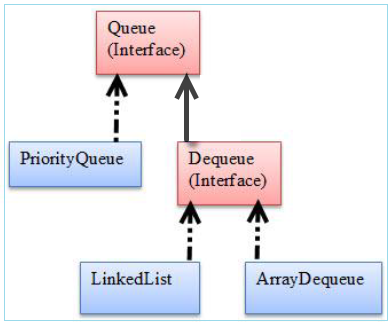

Stack : 10 was popped from the stackĪ BlockingQueue is an interface, which is a queue that blocks when you try to dequeue from it and the queue is empty, or if you try to enqueue items to it and the queue is already full. In the while loop below, the elements are removed from the Queue based on FIFO. This insertion operation is called enqueue. In the example below, with offer() method, the elements are inserted into the LinkedList. The class, while implementing is a general-purpose implementation of interface too operating on a FIFO (First In, First Out) (opens new window) principle. println ( queue ) //The Output: # LinkedList as a FIFO Queue

asList ( 9, 2, 3, 1, 3, 8 ) ) //The PriorityQueue sorts the elements by using compareTo method of the Integer Class //The head of this queue is the least element with respect to the specified ordering System. PriorityQueue queue = new PriorityQueue ( ) //The elements are added to the PriorityQueue The type of the PriorityQueue is Integer. AppDynamics and TIBCO BusinessWorks Instrumentation for Easy Integration.Using Other Scripting Languages in Java.Java Pitfalls - Nulls and NullPointerException.Java Pitfalls - Threads and Concurrency.Using ThreadPoolExecutor in MultiThreaded applications.Executor, ExecutorService and Thread pools.Parallel programming with Fork/Join framework.Visibility (controlling access to members of a class).Splitting a string into fixed length parts.Java Editions, Versions, Releases and Distributions.Thus it's important to check the implementation before using these methods, as it might result in unexpected locking, affecting the application's performance. The only case when the LinkedBlockingQueue methods will return immediately is if we use a bounded queue and this queue is empty or full. The LinkedBlockingQueue will block these operations. While ConcurrentLinkedQueue poll and offer as completely lock-free. However, because of different internal implementations, they behave differently. These queues use the Queue as the base interface and implement the poll and offer methods. It does not block the accessing thread when the queue is empty and returns null So, it blocks the accessing threads when the queue is empty It uses CAS (Compare-And-Swap) for its operations The put/take operations use the first lock type, and the take/poll operations use the other lock type In the two-lock queue algorithm mechanism, LinkedBlockingQueue uses two different locks – the putLock and the takeLock. It relies on the Michael & Scott algorithm for non-blocking, lock-free queues It implements its locking based on a two-lock queue algorithm It is an unbounded queue, and there is no provision to specify the queue size during creation It is an optionally bounded queue, which means there are provisions to define the queue size during the creation It is a non-blocking queue and does not implement the BlockingQueue interface It is a blocking queue and implements the BlockingQueue interface Therefore, the take method blocks the calling thread.Īlthough both of these queues have certain similarities, there are substantial characteristics differences, too: Feature
#JAVA QUEUE VS DEQUE CODE#
In the above code snippet, we are accessing an empty queue. LinkedBlockingQueue queue = new LinkedBlockingQueue() Similarly, if the queue is empty, then accessing an element blocks the calling thread: ExecutorService executorService = Executors.newFixedThreadPool(1) If the queue is full, then adding a new element will block the accessing thread unless there is space available for the new element.
#JAVA QUEUE VS DEQUE FULL#
The LinkedBlockingQueue class implements the BlockingQueue interface, which provides the blocking nature to it.Ī blocking queue indicates that the queue blocks the accessing thread if it is full (when the queue is bounded) or becomes empty. We can create a LinkedBlockingQueue from an existing collection as well: Collection listOfNumbers = Arrays.asList(1,2,3,4,5) īlockingQueue queue = new LinkedBlockingQueue(listOfNumbers) However, if there is no memory left, then the queue throws a.

Therefore, the queue can grow dynamically as elements are added to it. BlockingQueue unboundedQueue = new LinkedBlockingQueue() Īn unbounded queue implies that the size of the queue is not specified while creating.


 0 kommentar(er)
0 kommentar(er)
